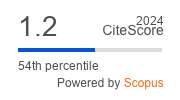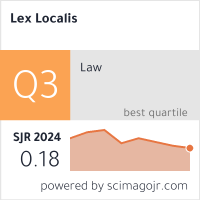The Impact of Maximum Allowable Debt Level of Local Government Units on their Investment Potential
DOI:
https://doi.org/10.4335/19.3.991-1014(2021)Keywords:
local government debt, investment potential, municipalities, fiscal rulesAbstract
Keeping local government units’ financial stability to run necessary projects is becoming a severe threat due to the remarkable increase of theirs’ debt level. A question arises whether the application of debt limits excessively restrict municipalities’ investment potential. Using the linear regression model, we proved that increasing the maximum allowable debt level decreases investment potential. We have challenged the relevance of using fiscal rules and presented liberalizing the fiscal rules’ principles to assess the investment potential as an indicator to guarantee optimum use of the local government units’ economic potential from different perspectives.
References
Barreyre, N. & Delalande, N. (2020) A world of public debts. A political history. Palgrave Studies in the History of Finance (London: Palgrave Macmillan).
Benito, B., Guillamón, M.-D. & Bastida, F. (2015) Non-Fulfilment of Debt Limits in Spanish Municipalities, Fiscal Studies, 36(1), pp. 75–98, https://doi.org/10.1111/j.1475-5890.2015.12046.x.
Bunch, B. S. (1991) The effect of constitutional debt limits on state governments’ use of public authorities, Public Choice, 68(1–3), pp. 57–69, https://doi.org/10.1007/BF00173819.
Checherita, C. & Rother, P. (2012) Debt and growth new evidence for the euro area, Working paper series no. 1450(July) (Frankfurt am Main: European Central Bank).
Dafflon, B. & Beer-Tóth, K. (2009) Managing local public debt in transition countries: An issue of self-control, Financial Accountability and Management, 25(3), pp. 305–333, https://doi.org/10.1111/j.1468-0408.2009.00479.x.
Debrun, X., Epstein, N. & Symansky, S. (2008) A new fiscal rule: Should Israel “go Swiss”?, IMF working paper WP/08/87 (Washington D.C.: IMF).
Deming, W. E. (1953) On the distinction between enumerative and analytic surveys, Journal of the American Statistical Association, 48(262), pp. 244-255.
Dessus, S., Diaz Sanchez, J. L. & Varoudakis, A. (2013) Fiscal rules and the procyclicality of public investment in the West African Economic and Monetary Union. The World Bank policy research working paper series no. 6562 (Washington D.C: World Bank).
Elliot, G. & Kearney, C. (1988) The intertemporal government budget constraint and tests for bubbles. Research discussion paper no. 8809 (Sydney: Reserve Bank of Australia).
Feld, L. & Kirchgässner, G. (2006) On the effectiveness of debt brakes: The Swiss experience. CREMA working paper series no. 2006-21 (Zürich: CREMA).
Freedman, D. A. (2005) Statistical Models: Theory and Practice (Cambridge, UK: Cambridge University Press).
Gras, E., Hernandez, J. & Palacios, M. (2014) An explanation of Local Government debt in Spain based on internal control system, Lex Localis- Journal of Local Self-Governent, 12(4), https://doi.org/10.4335/12.4.775-792(2014).
Guichard, S., Kennedy, M., Wurzel, E. & André, C. (2009) What promotes fiscal consolidation: OECD country experiences, OECD economics department working papers no. 553 (Paris: OECD Publishing).
Hildreth, W. B. & Miller, G. J. (2002) Debt and the local economy: Problems in benchmarking local government debt affordability, Public Budgeting and Finance, 22(4), pp. 99–113, https://doi.org/10.1111/1540-5850.00091.
Horvat, T., Vidmar, M., Justinek, G. & Bobek, V. (2020) Legislative, organisational, and economic factors of debt level of municipalities in Slovenia, Lex localis – Journal of Local Self-Government, 18(4), pp. 1065-1091.
Jimenez, B. S. (2018) Fiscal institutional externalities: The negative effects of local tax and expenditure limits on municipal budgetary solvency, Public Budgeting and Finance, 38(3), pp. 3–31, https://doi.org/10.1111/pbaf.12194.
Kiewiet, D. R. & Szakaty, K. (1996) Constitutional limitations on borrowing: An analysis of state bonded indebtedness, Journal of Law, Economics, and Organization, 12(1), pp. 62–97, https://doi.org/10.1093/oxfordjournals.jleo.a023362.
Kluza, K. (2016) Sustainability of local government sector debt. Evidence from Monte-Carlo simulations, Lex Localis - Journal of Self-Government, 14(1), pp. 115-132, https://doi.org/10.4335/115-132(2016).
Kopits, G. & Symansky, S. (1998) Fiscal policy rules, IMF. Occasional Papers No. 162. (Washington D.C.: International Monetary Fund).
Krueger, A. O. (1974) The political economy of the rent-seeking, Society, 64, pp. 291–303.
Levine, H., Justic, J. B. & Scorsone, E. A. (2013) Handbook of Local Government fiscal health (Burlington, MA: Jones and Bartlett Publishers).
Liu, L. & Waibel, M. (2010) Managing subnational credit and default risks. The World Bank policy research working paper no. 5362(8) (Washington D.C.: World Bank).
Minassian, T. (2007) Fiscal Rules for Subnational Governments: Can They Promote Fiscal Discipline?, OECD Journal on Budgeting, 6(3), p. 4.
Moszoro, M. W. & Spiller, P. T. (2019) Political contestability and public contracting, Journal of Public Economic Theory, 21(5), pp. 945–966, https://doi.org/10.1111/jpet.12325.
Ostry, D. J., Ghosh, R. A. & Espinoza, R. (2015) When should public debt be reduced, IMF staff discussion note, June 2015 SDN/15/10 (Washington D.C: IMF).
Plekhanov, A. & Singh, R. (2007) How should subnational government borrowing be regulated? Some cross-country empirical evidence, IMF Staff Papers, 5(54), pp. 426–443, https://doi.org/10.5089/9781451860733.001.
Schwarcz, S. L. (2002) Global decentralization and the subnational debt problem, Duke Law Journal, 51(4), pp. 1181–1182, https://doi.org/10.2307/1373119.
Shiyi, C. & Wang, L. (2019) Local government debt and regional economic growth in China, China Political Economy, 2, pp. 330–353.
Ter-Minassian, T. & Craig, J. (1997) Control of subnational government borrowing, In: Ter-Minassian, T. (ed) Fiscal federalism in theory and practice (Washington D.C.: International Monetary Fund), pp. 156–192.
Ter-Minassian, T. (2007) Fiscal rules for subnational governments: Can they promote fiscal discipline?, OECD Journal on Budgeting, 6(3), p. 4, https://doi.org/10.1787/budget-v6-art17-en.
Thornton, J. & Vasilakis, C. (2018) Fiscal rules and government borrowing costs: International evidence, Economic Inquiry, 56(1), pp. 446–459, https://doi.org/10.1111/ecin.12484.
Veiga, L. G. & Veiga, F. J. (2014) Determinants of Portuguese local governments’indebtedness, NIPE WP, 16, pp. 10–20.
Wassmer, R. W. & Fisher, R. C. (2011) State and local government debt, 1992–2008, State Tax Notes, August 15, p. 341.








